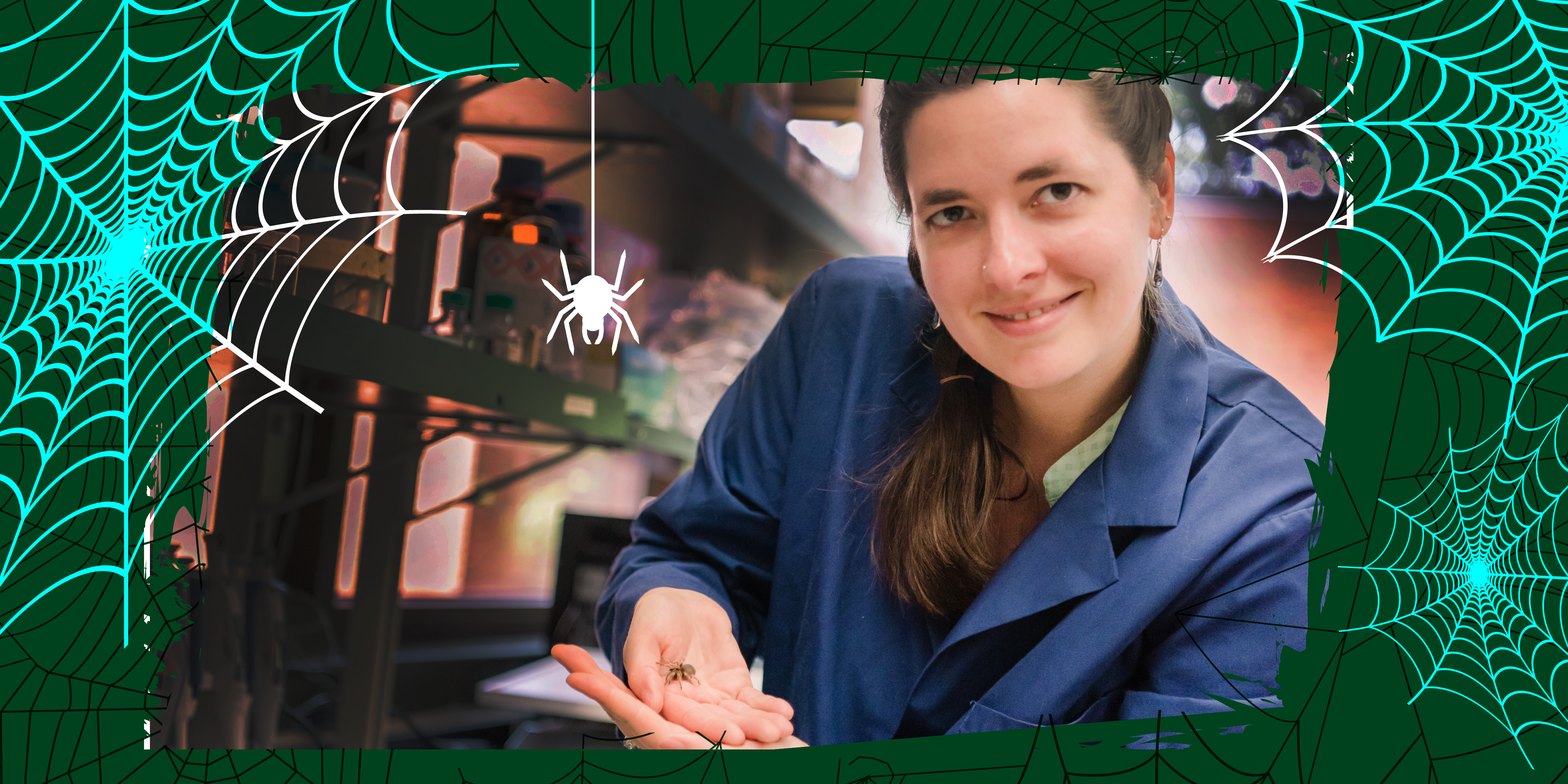Spiders and their sticky webs can seem scary, but for UNC Charlotte spider researcher Dr. Sarah Stellwagen, they are always a source for scientific discovery.
“I love Halloween, and I love that spiders get their special time of the year, because people spend most of the year being afraid of them or at least acting afraid of them,” said Stellwagen, a postdoctoral fellow in biological sciences. “Then Halloween rolls around, and everyone decorates their houses with spiders, and they put giant spiders up on their porches and spiderwebs in their bushes. I like that they get their chance to be celebrated.”
Stellwagen’s fascination with spiders started in a pet store at an early age. “When I was 11, there was a big hairy tarantula for sale at the local pet store. I saw her, and for whatever reason, it clicked in my brain, and I had to have that spider,” she said.
Now, she celebrates – and studies – spiders year-round. Her research centers on spider glues, gene discovery, and sequencing technologies. Specifically, she studies the sticky substance that spiders use to trap insects in a web.
She and collaborator Rebecca Renberg achieved the first-ever complete sequences of two genes that allow spiders to produce their glue, and published their findings in Genes, Genomes, Genetics. Stellwagen started the work as a postdoctoral fellow at the U.S. Army Research Laboratory, which funded the research, and published the findings as a postdoctoral fellow at University of Maryland, Baltimore County. The sequencing was so complex that it took two years to complete.
“We don’t have very many full length spider silk sequences in general, and the glue is really just a modified silk,” she said. “It has similar genetic properties to the other silks, in that they’re these huge genes that are repetitive. For the glue in particular, applications like biodegradable pest control are really important. The glue evolved to catch insects, so that would be a great use for it. It’s water soluble, it’s non-toxic, and it’s really good at doing what it does, which is keeping insects stuck.”
While these applications are well into the future, Stellwagen envisions a manufactured glue that could be sprayed directly on crops, or used in mosquito control, or even in ventilation to capture pests.
The innovative research moves science forward, with broader implications for future gene sequencing and advances in biomaterials.
“Silk genes are difficult to sequence,” she said. “They’re huge and they are extremely repetitive, and the sequencing technology that we’ve had in the past, which was fantastic for what it could do, wasn’t great at sequencing really long, really repetitive genes. Only in the past approximately five years has new sequencing technology come out that has allowed us to sequence complicated areas of genomes and things like spider silk genes.”
While more than 45,000 known species of spiders exist, the full genetic structure of spider silk is not well known because only about 30 complete genes have been sequenced.
Stellwagen was able to develop a protocol for sequencing these long, complex genes. In the past, technologies have been more “needle in the haystack” and yielded results less reliably, she said.
“That project was the first independent project I led after completing my Ph.D.,” she said. “I had this little bit of freedom, complete control of the project, and was able to work on it from the beginning to the end with my colleague to figure it out. It was very satisfying to be able to discover something that people had not yet been able to figure out.”
Stellwagen has completed gene sequencing of orb weaving spiders, which spin the classic spiral webs that can hit you in the face when you’re walking your dog In the woods, and would like to tackle others like the house spider, which makes a tangle web with lines that drop down from the web and loosely attach to the ground.
“At the bottom of those vertical lines are little droplets of glue, so a walking insect will come along and kind of bump into those glue droplets. Because the line is so loosely tied to the ground, the strand will release from the ground, pulling the insect into the air, where it will dangle until the spider can reel it in,” she said.
She is also interested in the genes of the Bolas spider, which releases a single strand of silk with a single glob of its glue on the end, which the spider twirls around and tosses into the air to catch moths. There are other glues made by other organisms, for predatory purposes, for attaching themselves to substrates, or for defense. Glowworms that live at the top of caves in Australia and New Zealand are one example. She would like to branch into this research in the future.
Stellwagen joined UNC Charlotte Biological Sciences researcher Adam Reitzel’s lab in summer 2020, adding her genetic sequencing knowledge to the Reitzel lab team. Her advice for students, particularly undergraduates, is to find researchers to work with who are doing research that “jazzes” them. “Research progresses the most and is the most fun when you are excited about it,” she said.
Listen to an interview Stellwagen did earlier in October with National Public Radio Station WYPR with its “On The Record” program.
Words: Lynn Roberson, CLAS Communications Director | Image: Marlayna Demond for UMBC | Illustrative Treatment: Ashley Plyler, CLAS Graphic Designer








